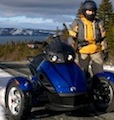|
-
-

We're 80 miles into the trip and all is well.
-
Registered User


 Originally Posted by SpyderGirl

We're 80 miles into the trip and all is well.

-
SpyderLovers Founder


 Originally Posted by SpyderFun

Lamont's video shows "slop" at the outer race area which is NOT normal (any slop there = immediate fix). 2 ways of fixing this kind of wear if it is severe enough. 1) replace bearing with an "oversize" bearing or 2) rework the surface area and install a race sleeve. I am not saying these are approved procedures but, this is the only way short of buying a new major assembly that I know of.
I've had pretty good luck through the years using a center punch to expand the race surface area and then using loctite on the bearing race. This is a real common problem when alloy wheels that are chromed and that's what we do to fix them.
By the way the hub was a lot cheaper than I thought it would be if you ever do have to replace it. List price is only $96 bucks and they sell a few bucks cheaper than that.
-

 Originally Posted by SpyderFun

Let me see if I can shed some light on this.
A bearing has an inner race (where the axle or bolt goes thru) and an outer race (the part that gets pressed into the hub or the next higher assembly). The inner race moves while the outer race remains stationary. Between them are the bearings (needle, roller, ball, etc) that allow this rotational movement.
Now if the outer race EVER begins to move or spin, then it has the potential of wearing out the surface it has been pressed into. In this case, the hub, has the potential to get out of its "roundness".
Lamont's video shows "slop" at the outer race area which is NOT normal (any slop there = immediate fix). 2 ways of fixing this kind of wear if it is severe enough. 1) replace bearing with an "oversize" bearing or 2) rework the surface area and install a race sleeve. I am not saying these are approved procedures but, this is the only way short of buying a new major assembly that I know of.
Bearings have 2 different "plays" to check for. One is radial (side to side) and the other is axial (in and out). Normal wear will have some slop or play. How much can you have BEFORE it must be replaced is the question. I am sure it is in the maintenance manual somewhere so I will not speak out on that limit.
A good practice, though not required, is to use a liquid bearing sealer around the outer race so when it is pressed in it dries and acts like a bonding agent between the two surfaces preventing a "spun race".
Hope this helped and sorry for the length.
Ride Smart ~ Ride Safe,
-Mike
This was an excellent explanation. Thank you very much for taking the time to write it up in such good detail. I get it now! Given that many of these parts are Aluminium alloy it's no wonder Doc was pointing it out. Again, information such as this is what makes this site special to all of us Spyder Riders, new and experienced alike. 
-
-
-

 Originally Posted by Lamonster

I've had pretty good luck through the years using a center punch to expand the race surface area and then using loctite on the bearing race..
For those that do not know, this procedure is called "Staking" a bearing in place. It is widely used in many industries and works well when combined with a bonding agent like Loc-Tite (we use to use some stuff called "Gorilla Snot").
What you are doing is basically expanding the outer race by "deforming" the very top edge of it so it "digs into" the mating surface. Like I said, works well just don't slip and "punch" the mating surface! This could cause micro-fractures thus reducing the life-cycle of the component & premature failure.
Step 1) prep installation area (clean hub!)
Step 2) inspect area for signs of damage or excessive wear
Step 3) apply bonding agent to mating surface (hub race)
Step 4) install bearing ("dry" press fit)
Step 5) "Stake" bearing in place - **ONLY IF NEEDED**
But at less than a $100.00, if bearing area of your hub is really that bad - I say buy a new hub to put your new bearing(s) into! 
 Posting Permissions
Posting Permissions
- You may not post new threads
- You may not post replies
- You may not post attachments
- You may not edit your posts
-
Forum Rules
|

